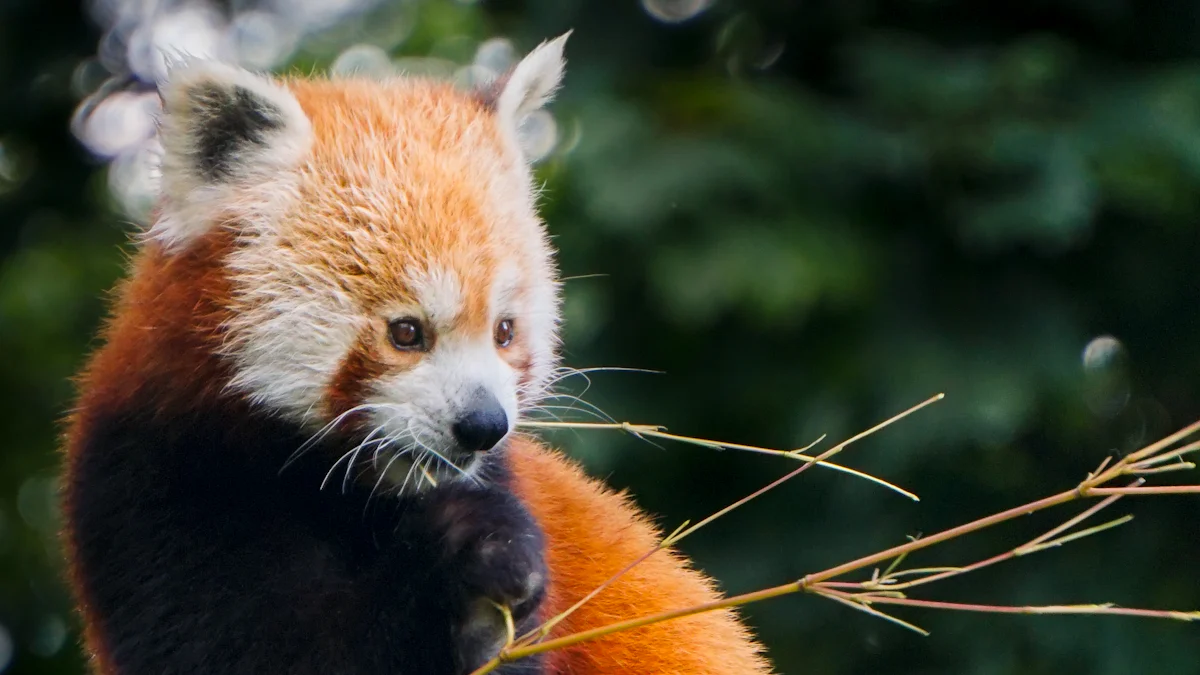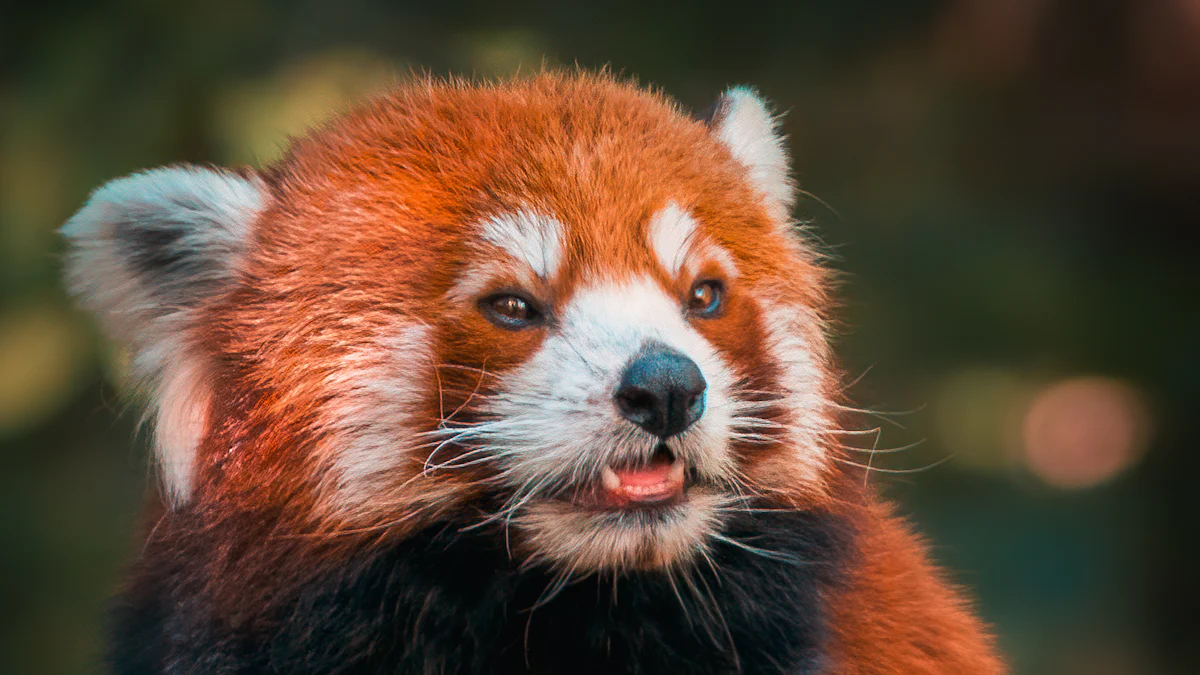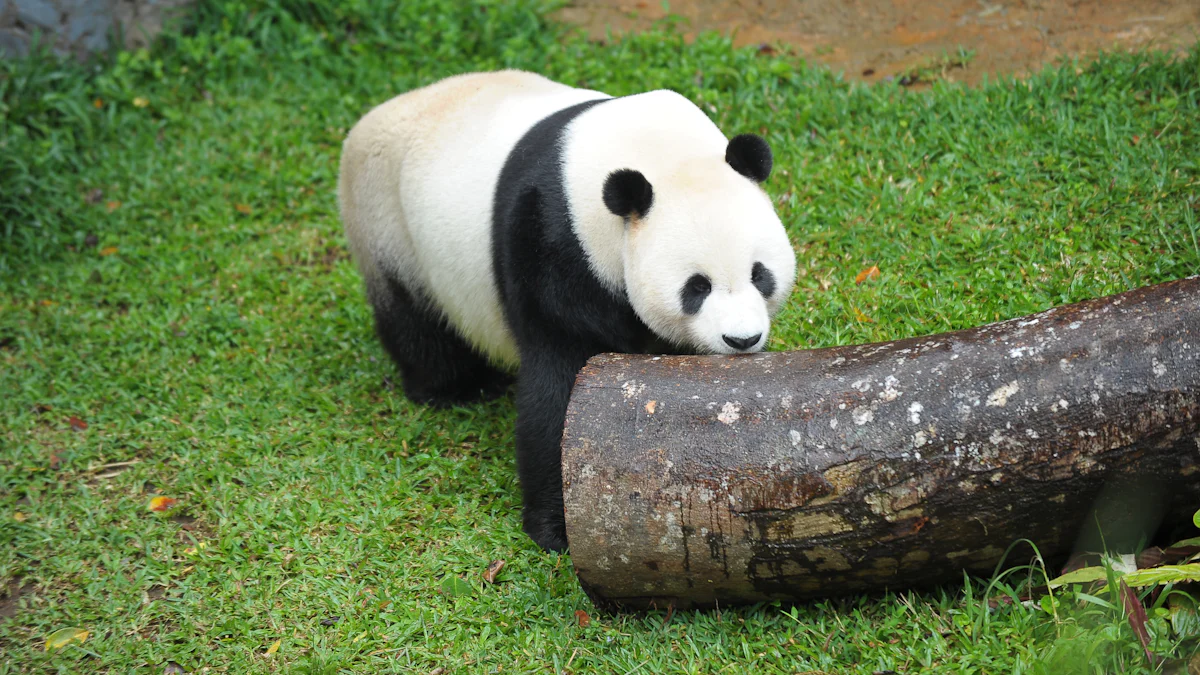
You might often confuse the Giant Panda with the Red Panda. Despite their shared name, these two creatures differ significantly. Understanding their differences and similarities can enrich your knowledge of wildlife. The Giant Panda, with its iconic black and white fur, stands out in size and appearance. In contrast, the Red Panda, smaller and more elusive, captivates with its reddish-brown coat. By exploring these fascinating animals, you gain insight into their unique characteristics and the importance of preserving their habitats.
Key Takeaways
-
Giant Pandas and Red Pandas belong to different families, with the Giant Panda classified under Ursidae (bears) and the Red Panda under Ailuridae, highlighting their distinct evolutionary paths.
-
Despite their names, these pandas differ significantly in size; Giant Pandas can weigh up to 300 pounds, while Red Pandas weigh only 7 to 13 pounds, emphasizing their unique adaptations to their environments.
-
Both species primarily feed on bamboo, but the Giant Panda's diet is almost exclusively bamboo, while the Red Panda enjoys a more varied diet that includes fruits and insects, showcasing their dietary flexibility.
-
Giant Pandas are primarily solitary and spend most of their day eating, while Red Pandas are nocturnal and more agile, reflecting their adaptations to different habitats.
-
Conservation efforts have led to the Giant Panda's status improving from endangered to vulnerable, while the Red Panda remains endangered, underscoring the need for continued conservation initiatives.
-
Understanding the unique characteristics and challenges faced by both species can empower you to support wildlife conservation efforts and help protect their habitats.
Taxonomy and Classification
Understanding the taxonomy and classification of the Giant Panda and Red Panda helps you appreciate their unique evolutionary paths. Despite their shared name, these two species belong to different families and have distinct evolutionary backgrounds.
Scientific Classification
The Giant Panda, scientifically known as Ailuropoda melanoleuca, belongs to the Ursidae family, which includes bears. This classification places it alongside other bear species, highlighting its bear-like characteristics. On the other hand, the Red Panda, or Ailurus fulgens, is a member of the Ailuridae family. This family is unique to the Red Panda, setting it apart from the Giant Panda and other animals.
Evolutionary Background
Both the Giant Panda and Red Panda share a common ancestry, but they diverged approximately 43 million years ago. This divergence led them down separate evolutionary paths. Interestingly, both species developed a bamboo-based diet independently, showcasing a fascinating example of convergent evolution. They even evolved similar adaptations, like their "fake thumbs," to aid in bamboo consumption. Despite being classified as carnivores, both pandas adapted to a herbivorous lifestyle, primarily feeding on bamboo. The Red Panda's closest relatives include skunks, raccoons, and weasels, which might surprise you given its panda name.
Physical Characteristics

When you compare the physical characteristics of the Giant Panda and the Red Panda, you'll notice some striking differences and similarities. These features not only define their appearance but also influence their behavior and habitat preferences.
Size and Weight
The size and weight of these pandas differ significantly. The Giant Panda stands out with its impressive size. It can reach lengths of 4 to 6 feet and weigh between 150 to 300 pounds. Imagine a creature that can weigh as much as a small motorcycle! In contrast, the Red Panda is much smaller and lighter. It measures about 20 to 25 inches in length and weighs only 7 to 13 pounds. To put it in perspective, about 30 Red Pandas would equal the weight of one Giant Panda. This size difference plays a crucial role in their respective lifestyles and habitats.
Color and Body Shape
Color and body shape further distinguish these two species. The Giant Panda is famous for its distinctive black and white pattern. Its round face and robust body give it a bear-like appearance. This coloration helps it blend into the snowy and rocky environments of central China. On the other hand, the Red Panda boasts a beautiful reddish-brown fur with white markings on its face and ears. Its long, bushy tail adds to its charm and aids in balancing while navigating the trees of the Himalayas and southwestern China. The Red Panda's coloration provides excellent camouflage among the reddish-brown moss and lichen-covered trees.
By understanding these physical characteristics, you gain a deeper appreciation for how each panda has adapted to its environment. Their unique features not only make them fascinating to observe but also highlight the importance of preserving their natural habitats.
Diet and Feeding Habits
When you explore the diet and feeding habits of the Giant Panda and Red Panda, you'll find fascinating adaptations that allow them to thrive on a bamboo-based diet. Despite their differences, both species have evolved unique ways to consume and digest bamboo.
Dietary Preferences
The Giant Panda primarily relies on bamboo for its diet. It consumes up to 20 kilograms of bamboo daily. This massive intake is necessary because bamboo is low in nutrients. The Giant Panda's digestive system has adapted to process this fibrous plant efficiently. Its strong jaw muscles and molars help it crush bamboo stems and leaves.
In contrast, the Red Panda has a more varied diet. While bamboo makes up about 95% of its diet, it also eats fruits, insects, and small animals. This variety helps the Red Panda meet its nutritional needs. The Red Panda selectively feeds on the most nutritious parts of the bamboo, such as tender shoots and leaf tips. This selective feeding behavior ensures it gets the maximum benefit from its meals.
Feeding Behavior
Both pandas exhibit unique feeding behaviors that reflect their dietary adaptations. The Giant Panda uses its wrist bones, which function like thumbs, to grasp bamboo stalks. This adaptation allows it to hold and manipulate bamboo with ease. You might find it interesting that despite being classified as carnivores, Giant Pandas have evolved to thrive on a herbivorous diet.
Red Pandas, on the other hand, have developed opposable thumbs to help them grasp branches and bamboo. They often climb trees to find the best bamboo shoots. Their feeding behavior is more agile and selective compared to the Giant Panda. Red Pandas prefer to eat alone, avoiding competition with other animals for food.
Both species have specialized gut microbiota that aids in the digestion of bamboo. This adaptation is crucial for breaking down the tough cellulose found in bamboo. By understanding these feeding habits, you gain insight into how each panda species has uniquely adapted to its environment.
Habitat and Lifestyle

Natural Habitat
When you look at the natural habitats of the Giant Panda and Red Panda, you'll notice they both thrive in regions rich in bamboo. However, their specific environments differ. The Giant Panda primarily inhabits the misty, mountainous forests of central China. These areas provide the dense bamboo forests that are crucial for their survival. The thick vegetation offers not only food but also shelter and protection.
In contrast, the Red Panda prefers the temperate forests of the Himalayas and southwestern China. These forests are characterized by a mix of deciduous and coniferous trees, which provide a diverse ecosystem. The Red Panda's habitat is more specialized, requiring specific microclimatic conditions and a particular distribution of bamboo species. This makes them more vulnerable to habitat changes and highlights the need for targeted conservation efforts.
Daily Activities and Behavior
The daily activities and behaviors of these pandas reflect their adaptations to their respective environments. Giant Pandas spend most of their day eating bamboo. They consume large quantities to meet their energy needs. You might find it interesting that they are generally solitary animals, coming together only during the breeding season. Their slow and deliberate movements match their laid-back lifestyle.
On the other hand, Red Pandas lead a more active lifestyle. They are primarily nocturnal, which means they are most active during the night. During the day, they rest in trees, using their bushy tails for warmth and balance. Red Pandas are also solitary creatures, except during mating season or when raising young. Their agility allows them to navigate the forest canopy with ease, searching for the most nutritious bamboo shoots and other food sources like fruits and insects.
Both species have adapted to their environments in unique ways. The Giant Panda's robust build suits its ground-dwelling lifestyle, while the Red Panda's agility and climbing skills make it a master of the treetops. By understanding these differences, you gain a deeper appreciation for how each species has carved out its niche in the wild.
Reproduction and Lifespan
Reproductive Behavior
When you dive into the reproductive behavior of Giant Pandas and Red Pandas, you'll find intriguing differences. Giant Pandas have a unique reproductive cycle. Female Giant Pandas ovulate only once a year, which makes breeding a challenging task. This brief window for mating requires precise timing and conditions. After mating, the gestation period lasts about 95 to 160 days. Typically, a female gives birth to one or two cubs, but often only one survives due to the mother's limited ability to care for multiple offspring.
In contrast, Red Pandas reproduce more frequently. They mate from January to March, with a gestation period of about 112 to 158 days. By June or July, the female gives birth to 2 to 4 cubs. These cubs are born blind and deaf, relying entirely on their mother for warmth and protection. Red Pandas are solitary creatures, coming together only during the breeding season. The mother raises the cubs alone, providing them with care until they mature.
Lifespan and Growth
The lifespan and growth patterns of these pandas also differ. Giant Pandas can live up to 20 years in the wild and even longer in captivity, sometimes reaching 30 years. Their growth is relatively slow. Cubs are born tiny and helpless, weighing just about 3 to 5 ounces. They grow rapidly, reaching full size by the age of 4 to 6 years. During this time, they learn essential survival skills from their mothers.
Red Pandas, on the other hand, have a shorter lifespan. In the wild, they typically live around 8 to 10 years, while in captivity, they can reach up to 15 years. Red Panda cubs grow quickly, becoming independent by the age of one year. They reach sexual maturity at about 18 months, allowing them to reproduce sooner than Giant Pandas.
Understanding these reproductive behaviors and lifespans highlights the unique challenges each species faces in the wild. While Giant Pandas struggle with limited breeding opportunities, Red Pandas must contend with environmental threats that impact their shorter lifespans. Both species require dedicated conservation efforts to ensure their survival for future generations.
Conservation Status and Efforts
When you think about the conservation status of the Giant Panda and Red Panda, you'll find that both species face significant challenges. However, their conservation stories differ in many ways.
Current Conservation Status
The Giant Panda has become a symbol of conservation success. Once classified as endangered, it has been downlisted to "vulnerable" on the IUCN Red List due to extensive conservation efforts. These efforts include habitat restoration, anti-poaching measures, and successful breeding programs. The Chinese government, along with international organizations, has played a crucial role in these initiatives. As a result, the Giant Panda population has seen a steady increase in recent years.
In contrast, the Red Panda remains endangered. Its population continues to decline due to habitat loss, poaching, and climate change. The IUCN Red List highlights the urgent need for conservation action to protect this species. Unlike the Giant Panda, the Red Panda's conservation efforts have not yet achieved the same level of success. This highlights the need for increased attention and resources to safeguard its future.
Conservation Challenges and Initiatives
Both pandas face unique conservation challenges. For the Giant Panda, habitat fragmentation poses a significant threat. Although their numbers are increasing, pandas remain confined to isolated patches of bamboo forests. To address this, conservationists focus on creating wildlife corridors to connect these fragmented habitats. This allows pandas to roam freely and access more resources.
The Red Panda faces even more daunting challenges. Habitat loss due to deforestation and agricultural expansion is a major concern. Climate change further exacerbates these issues by altering the distribution of bamboo, their primary food source. Conservation efforts for Red Pandas involve multiple stakeholders, including governments, NGOs, and local communities. Initiatives focus on protecting habitats, reducing human-induced threats, and raising public awareness.
Organizations like the World Wildlife Fund and Natural Habitat Adventures work tirelessly to protect both panda species. They collaborate with local communities to implement sustainable practices and promote eco-tourism. Public awareness campaigns and educational programs play a vital role in highlighting the importance of Red Panda conservation.
By understanding these conservation efforts, you can appreciate the dedication required to protect these iconic species. Supporting these initiatives ensures that future generations can enjoy the beauty and uniqueness of both the Giant Panda and Red Panda.
In comparing the Giant Panda and Red Panda, you see both striking differences and intriguing similarities. The Giant Panda, with its larger size and distinct black and white fur, contrasts sharply with the smaller, reddish-brown Red Panda. Yet, both share a love for bamboo and face significant conservation challenges. Protecting their habitats is crucial for their survival. You can play a part by supporting wildlife conservation initiatives. Every effort counts in ensuring these unique creatures continue to thrive in their natural environments.
FAQ
What is the diet difference between Giant Pandas and Red Pandas?
Giant Pandas primarily munch on bamboo. They consume large amounts daily to meet their energy needs. Red Pandas, however, enjoy a more varied menu. While bamboo remains a staple, they also snack on fruits, insects, and small animals. This omnivorous diet helps them get the nutrients they need.
How do the conservation statuses of Giant Pandas and Red Pandas differ?
Giant Pandas have made significant strides in conservation. Once endangered, they now hold a "vulnerable" status thanks to dedicated efforts. Red Pandas, on the other hand, remain endangered. Their numbers continue to decline due to habitat loss and other threats. Both species need ongoing support to thrive.
Why do Giant Pandas and Red Pandas share a name if they're so different?
Despite their shared name, these pandas belong to different families. The Giant Panda is part of the Ursidae family, which includes bears. The Red Panda belongs to the Ailuridae family, unique to them. Their name similarity stems from their shared bamboo diet and some behavioral traits.
How do their physical sizes compare?
Giant Pandas are much larger. They can weigh between 150 to 300 pounds and stretch up to 6 feet long. Red Pandas, in contrast, are petite. They weigh around 7 to 13 pounds and measure about 20 to 25 inches in length. Imagine the size difference as comparing a motorcycle to a small dog!
What are their natural habitats like?
Giant Pandas live in the misty, mountainous forests of central China. These areas are rich in bamboo, their primary food source. Red Pandas prefer the temperate forests of the Himalayas and southwestern China. Their habitats feature a mix of trees and require specific conditions for survival.
How do their reproductive behaviors differ?
Giant Pandas have a narrow breeding window. Females ovulate once a year, making timing crucial. They usually give birth to one or two cubs. Red Pandas breed more frequently, with females giving birth to 2 to 4 cubs. Their reproductive cycles allow for more frequent population growth.
What unique adaptations do they have for eating bamboo?
Both pandas have developed "fake thumbs" to help them grasp bamboo. Giant Pandas use their wrist bones like thumbs to hold and manipulate bamboo stalks. Red Pandas have opposable thumbs that aid in climbing and selecting the best bamboo shoots. These adaptations highlight their specialized diets.
How do their lifespans compare?
Giant Pandas can live up to 20 years in the wild and even longer in captivity. Red Pandas have a shorter lifespan, typically living around 8 to 10 years in the wild. In captivity, they might reach up to 15 years. These differences reflect their unique life challenges and environments.
What role do they play in their ecosystems?
Both pandas play vital roles in their ecosystems. Giant Pandas help maintain the health of bamboo forests by spreading seeds and creating clearings. Red Pandas contribute to the balance of their forest habitats by controlling insect populations and aiding in seed dispersal. Their presence supports biodiversity.
How can you help in their conservation efforts?
You can support conservation efforts by donating to organizations dedicated to protecting these species. Participating in eco-friendly practices and spreading awareness about their plight also makes a difference. Every action counts in ensuring these unique creatures continue to thrive in their natural environments.






3 thoughts on “Giant Panda vs Red Panda”
TestUser
AlhTj wUiHwJE rvCuk
MyName
zdjT YDvwT xSJWKkNK zDZMeO nIhKvoL
TestUser
BFyXM mCrWhPpt FpqU AGw